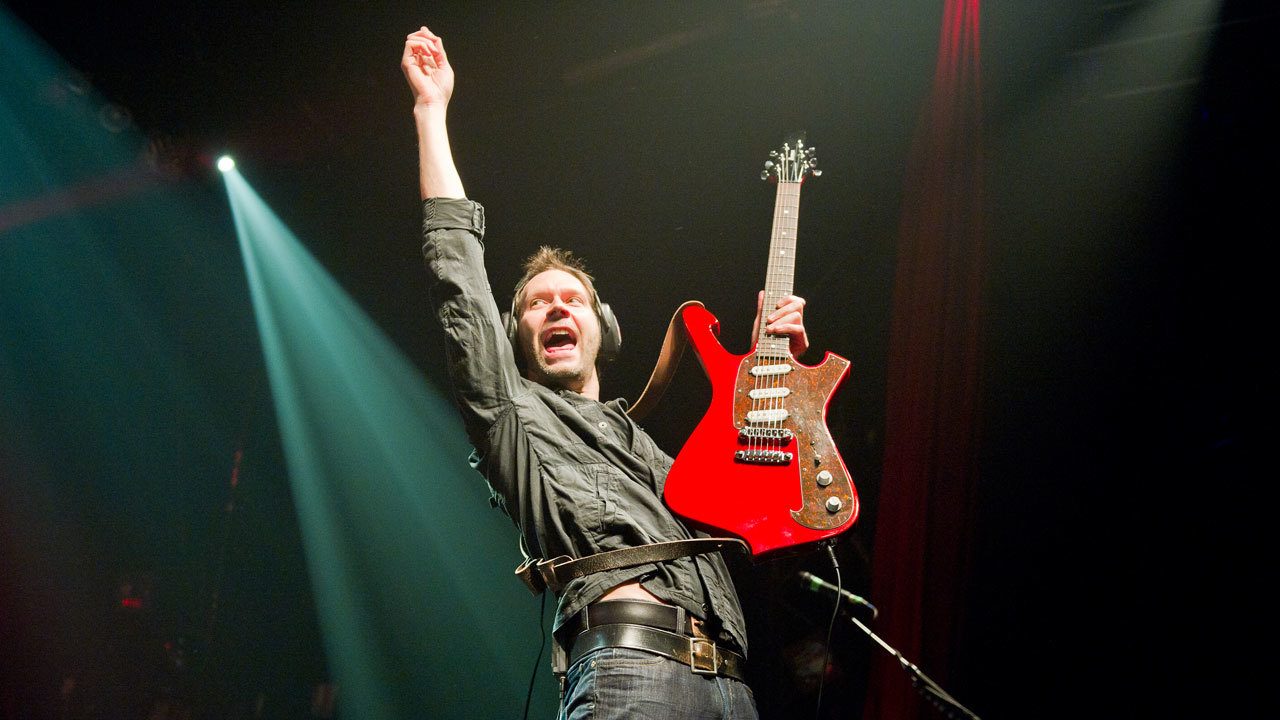Paul Gilbert fans will find much to celebrate this year when the virtuoso guitarist issues his 14th solo album, the Kevin Shirley-produced I Can Destroy. In addition, Gilbert has just announced his Great Guitar Escape 3.0, four nights of total axe immersion, to be held from July 25-29 at the Cambria Pines Lodge in Cambria, CA.
With so much six-string goodness on the way, it seemed like the perfect time for Classic Rock to check in with the shredtastic one and ask him to weigh in on his five essential guitar albums.
What’s your criteria for what constitutes an “essential guitar album”?
“No one can choose their biological DNA, but you can choose what music you listen to. I listened to these records so much when I was a kid that they shaped my musical DNA. I slowed the albums down and panned the speakers to one side, just so I could hear the guitar better. I took them to my local guitar teacher to ask for help figuring out licks. I played the songs with my teenage basement bands, and when no one was watching, I put in hours air-guitaring in front of the mirror to them.
“I learned the drum and bass parts, and I even sang some of them if the singer dipped low enough for my vocal range. I stared at the album covers and memorized the liner notes. I even melted a few copies by leaving them under the back window of the family car on a sunny day. These records certainly weren’t essential to the other kids in my class, who were listening to Shaun Cassidy and Leif Garrett, and later Bruce Springsteen, but they were certainly essential to me.”
When you hear a great guitar album, does it cause you to take any sort of action, as in, “I’ve got to figure out how to play that”?
“I seemed to have a lot more free time when I was 14 years old. I had to go to school, of course, but the rest of my time was open, and I could really dig in to practicing during summer vacations. So I could really get deep into these albums at the time.
“I still like to figure out music that’s interesting to me, but that’s usually not guitar music these days. It will be some chords that one of those smart keyboard players knows how to use, or a solo by someone playing a horn. Or a great vocal melody. I still dig guitar, of course, but I hear enough of it from just being around myself. And if things are going really well, I can just listen to what is coming out of my imagination.”
How do you react when people toss around superlatives about your own playing?
“I used to keep a narrow focus on my career in Japan, which for a long time, was a pretty astounding thing. I was winning ‘best guitarist’ in the magazine polls, and appearing on magazine covers as much as any other guitar star in the world. But in the last 10 years, I’ve expanded my view, and I’ve realized that the world is much bigger and that my impact on the global guitar community is much smaller than I once imagined.
“Also, my musical tastes have changed, and I’m just not that interested in a lot of the music that I made in the past. Of course, it’s nice to receive a compliment. But I’m mostly thankful that people are still interested in me, and that I have a chance to do new stuff. If I were really courageous, I would change my name. I actually joined a great, nasty pop-punk band years ago and used the stage name ‘Dick Image.’ I had the best time, and I seemed to do better with the ladies.
“Now, I’d like to be ‘Otis Fieldsgood’ and play slow blues all night. But I’d probably sell about two records, and I’d still play too many notes most of the time. Also, I do have to pay the bills, so I can’t mess with the brand too much. Paul Gilbert, shredder, I remain.”
Paul Gilbert’s Great Guitar Escape 3.0 includes guest instructors Dave Ellefson and Kiko Loureiro (Megadeth) Ron “Bumblefoot” Thal (Art of Anarchy, ex-GNR), Andy Timmons (Danger Danger) and Bruce Bouillet (Racer X, The Scream). Interested in attending? Visit the event’s official site.
Below, Gilbert runs down his five essential guitar albums.
Robin Trower – Bridge of Sighs (1974)
“Whenever I want to play better, I just imagine that Robin Trower is listening. I picture him standing at the mixing board and thinking, ‘Oh, this is dreadful.’ And then I’d have quit widdly-ing and start playing phrases that mean something, just so he won’t leave.
Bridge of Sighs is a whole album of phrases that mean something. Robin is sometimes accused of sounding too much like Jimi Hendrix. Since I’m a Hendrix fan, I enjoy any similarities, but to my ears Robin has carved out something that is completely his own. Plus he’s still making records and playing shows. Go see him and hear what vibrato is supposed to be. Every time Robin Trower bends a note, 1,000 kids with wanky vibrato who are trying out guitars at Guitar Center mysteriously vanish.”
Pat Travers – Go For What You Know (1979)
Pat Travers and Pat Thrall, for a brief time, were the coolest dual-guitar team rock has known. This album captures their amazing solo trade-offs, soaring harmonies and super-tight funk-rock rhythm arrangements, all with the energy of a live show and whatever self-medication was available at the time. ‘Snortin’ whiskey and drinkin’ cocaine’ was a lyric from their hit on the studio record that followed.
“This kind of band just doesn’t exist anymore – yes, I’m getting nostalgic. You can hear the massive amounts of rehearsal that went into their playing – they’re both so tight. You can hear their love of music from the broad array of styles that they draw from. You can also hear the depth of their musicianship. There’s no nerdiness, except for that lyric about the ‘Irish Setter, settin’ all the time.’
“And there’s no hint of scale practice or academia. It’s all rock and anger, but with a nice dose of sophistication. The album is also drummer Tommy Aldridge’s best work.”
Frank Marino & Mahogany Rush – Live (1978)
(In a low, menacing voice) “’Ladies and Gentleman… Will you please welcome… Frank Marino… and MaHOOOOOOOgany Rush…’ BOOM!
“This album is another example of superior shred being produced before ‘shred’ was a musical term. Frank Marino plays blindingly fast guitar with a tone that sounds like it will form a new indestructible metal alloy – once it cools. Only it stays molten for the whole record.
“Frank is another victim of Hendrix-clone accusations. He does cover Purple Haze, and he also does Johnny B. Goode, which Hendrix covered, but to my ear, Frank’s playing and tones have a flavour and intensity that are unique to him.
“I still marvel at Frank’s jazz lines in I’m a King Bee. I’ve tried working on similar changes for years, and I still don’t get close to how good he sounds. Either Frank is really smart, or I’m really dumb. But let’s take me out of the equation – just listen to the record and dig it!”
Van Halen – Van Halen (1978)
“This album is just unfair to everyone. Eddie’s innate musical genius ears, combined with the athletic prowess he got from eight-hours-a-day bedroom practicing, along with an indestructible rhythmic groove developed from jamming with his brother, results in a record of non-stop jaw-dropping awesomeness.
“Nobody knew what to do when this album came out. Imitation was fun but futile. The best thing to do was just go see the live show – to laugh, scream and join the party. And don’t forget David Lee Roth lines like, ‘Goddamn it, baby. I ain’t lyin’ to ya. I’m only gonna tell you one ti-ii-ime… AHHHHHHHH YAAAAAHHHH!’
“If we guitarists could just get our Variacs on the right setting, we could finally all get Eddie’s mythical tone. Pheeeeeshh, it ain’t the gear! I am starting to notice a pattern here, that many of the best rock musicians had fathers who played jazz clarinet. Wanna sound like Eddie? Better start digging Artie Shaw. ‘Bop na na shoobie doo-wah!’ Seriously, I’m way into the clarinet these days. Suddenly, all of those Woody Allen movie intros sound way more cookin’.”
Led Zeppelin – The Song Remains the Same (1976)
“Before there was guitar, there was air guitar, at least for me. I spent years in front of the mirror with my Sears ‘Deluxe’ stamped-aluminium, suction-cup, yarn-cabled toy guitar before I ever played a note on an actual instrument.
“My mom was cool enough to take me to see The Song Remains the Same at a midnight showing. I was surprised at how boring the jams were and how few of the songs I knew. But I bought the soundtrack album anyway, and it grew on me. And grew. And grew. Until I could follow every Jimmy Page riff, solo, violin-bow howl, Theremin scream, and wah-wah move… all performed while pouting, duck-walking and strutting around Madison Square Garden, with a Les Paul slung low and pants worn unusually high to maximise the effect – a trick I didn’t work out until years later and am still hesitant to imitate.
“The boredom was gone. This was the best air-guitar workout imaginable! Jimmy had one other trick up his sleeve that put him far beyond his Yardbirds alumni. That trick?… Forming a rock band with Robert Plant, John Paul Jones and John Bonham. It took decades for my body to feel old and tired enough where I could begin to appreciate the low-energy goodness of the Clapton records that came out around the same time, or the singerless guitar fusion of Jeff Beck. As Robert Plant scats in ‘Whole Lotta Love,’ “He’s got to Boogie! He’s got to Boogie! Boogie! Boo-boo boo-boo baa-baa baa-waa-waa… BOOGIE!’ Ahh, have mercy.”

